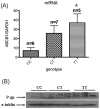Increased risk for congenital heart defects in children carrying the ABCB1 Gene C3435T polymorphism and maternal periconceptional toxicants exposure
- PMID: 23874772
- PMCID: PMC3714281
- DOI: 10.1371/journal.pone.0068807
Increased risk for congenital heart defects in children carrying the ABCB1 Gene C3435T polymorphism and maternal periconceptional toxicants exposure
Abstract
Backgrounds: The etiology of congenital heart defect (CHD) is commonly believed to involve the interaction of multiple environmental and genetic factors. This study aimed to explore the joint effects of the ABCB1 gene C3435T polymorphism and maternal periconceptional toxicants exposure on the CHD risk in a Han Chinese population.
Methods: An age and gender matched case-control study with standardized data collection involving 201 pairs was conducted. Periconceptional toxicants exposure was obtained through a structured questionnaire. A job exposure matrix (JEM) was used for toxicants exposure assessment. Genotyping of the ABCB1 C3435T polymorphism was performed by sequencing. Logistic regression analysis was performed to assess the joint effects of the ABCB1 gene C3435T polymorphism and toxicants exposure on the risk of CHD. Placenta tissues and umbilical cords were collected to investigate the impact of C3435T polymorphism on the transcription and translation activities of ABCB1 gene.
Results: MATERNAL PERICONCEPTIONAL EXPOSURES TO PHTHALATES (ADJUSTED OR: 1.6; 95%CI: 1.0-2.6) and alkylphenolic compounds (adjusted OR:1.8; 95%CI:1.1-3.0) were associated with a higher incidence of CHDs in general. More cases were carriers of the ABCB1 CC/CT genotypes (OR: 2.0, 95%CI: 1.1-3.5, P-value: 0.021). Children carrying the CC/CT genotype and periconceptionally exposed to phthalates and alkylphenolic compounds suffered almost 3.5-fold increased risk of having CHD than non-exposed children with TT genotype (adjusted OR: 3.5, 95%CI: 1.5-7.9, P-value: 0.003), and the OR changed to 4.4 for septal defects (adjusted OR: 4.4,95%CI:1.8-10.9,P-value:0.001). The ABCB1 mRNA expression of the TT genotype was significantly higher than that of the CC genotype (P = 0.03). Compared with TT genotype, lower P-glycoprotein expression was observed for the CC/CT genotypes.
Conclusion: The C3435T polymorphism in the ABCB1 gene of fetus increases the risks of CHD in a Han Chinese population when the mothers are exposed to phthalates and alkylphenolic compounds during the periconceptional period, particularly for septal defects.
Conflict of interest statement
Figures

Similar articles
-
Maternal medication use, fetal 3435 C>T polymorphism of the ABCB1 gene, and risk of isolated septal defects in a Han Chinese population.Pediatr Cardiol. 2014 Oct;35(7):1132-41. doi: 10.1007/s00246-014-0906-6. Epub 2014 Apr 17. Pediatr Cardiol. 2014. PMID: 24740628
-
Association between ABCB1 C3435T polymorphism and breast cancer risk: a Moroccan case-control study and meta-analysis.BMC Genet. 2016 Sep 1;17(1):126. doi: 10.1186/s12863-016-0434-x. BMC Genet. 2016. PMID: 27580695 Free PMC article.
-
Associations between ABCG2 gene polymorphisms and isolated septal defects in a Han Chinese population.DNA Cell Biol. 2014 Oct;33(10):689-98. doi: 10.1089/dna.2014.2398. Epub 2014 Jun 30. DNA Cell Biol. 2014. PMID: 24979295 Free PMC article.
-
Effects of the ABCB1 C3435T single nucleotide polymorphism on major adverse cardiovascular events in acute coronary syndrome or coronary artery disease patients undergoing percutaneous coronary intervention and treated with clopidogrel: A systematic review and meta-analysis.Expert Opin Drug Saf. 2020 Dec;19(12):1605-1616. doi: 10.1080/14740338.2020.1836152. Epub 2020 Oct 23. Expert Opin Drug Saf. 2020. PMID: 33040624
-
Association of ABCB1 C3435T polymorphism with the susceptibility to osteonecrosis of the femoral head: A meta-analysis.Medicine (Baltimore). 2017 May;96(20):e6049. doi: 10.1097/MD.0000000000006049. Medicine (Baltimore). 2017. PMID: 28514285 Free PMC article. Review.
Cited by
-
Maternal obesity and tobacco use modify the impact of genetic variants on the occurrence of conotruncal heart defects.PLoS One. 2014 Oct 2;9(9):e108903. doi: 10.1371/journal.pone.0108903. eCollection 2014. PLoS One. 2014. PMID: 25275547 Free PMC article.
-
Genetic variation affects congenital heart defect susceptibility in offspring exposed to maternal tobacco use.Birth Defects Res A Clin Mol Teratol. 2015 Oct;103(10):834-42. doi: 10.1002/bdra.23370. Epub 2015 Jun 2. Birth Defects Res A Clin Mol Teratol. 2015. PMID: 26033827 Free PMC article. Clinical Trial.
-
Genetic and Epigenetic Mechanisms Linking Air Pollution and Congenital Heart Disease.J Cardiovasc Dev Dis. 2016 Nov 29;3(4):32. doi: 10.3390/jcdd3040032. J Cardiovasc Dev Dis. 2016. PMID: 29367575 Free PMC article. Review.
-
PITX2 Loss-of-Function Mutation Contributes to Congenital Endocardial Cushion Defect and Axenfeld-Rieger Syndrome.PLoS One. 2015 Apr 20;10(4):e0124409. doi: 10.1371/journal.pone.0124409. eCollection 2015. PLoS One. 2015. PMID: 25893250 Free PMC article.
-
Association of maternal phthalates exposure and metabolic gene polymorphisms with congenital heart diseases: a multicenter case-control study.BMC Pregnancy Childbirth. 2024 Feb 26;24(1):167. doi: 10.1186/s12884-024-06343-z. BMC Pregnancy Childbirth. 2024. PMID: 38408952 Free PMC article.
References
-
- Pierpont ME, Basson CT, Benson DW Jr, Gelb BD, Giglia TM, et al. (2007) Genetic basis for congenital heart defects: current knowledge: a scientific statement from the American Heart Association Congenital Cardiac Defects Committee, Council on Cardiovascular Disease in the Young: endorsed by the American Academy of Pediatrics. Circulation 115: 3015–3038. - PubMed
-
- Jenkins KJ, Correa A, Feinstein JA, Botto L, Britt AE, et al. (2007) Noninherited risk factors and congenital cardiovascular defects: current knowledge: a scientific statement from the American Heart Association Council on Cardiovascular Disease in the Young: endorsed by the American Academy of Pediatrics. Circulation 115: 2995–3014. - PubMed
-
- Thulstrup AM, Bonde JP (2006) Maternal occupational exposure and risk of specific birth defects. Occup Med (Lond) 56: 532–543. - PubMed
Publication types
MeSH terms
Substances
LinkOut - more resources
Full Text Sources
Other Literature Sources
Medical

